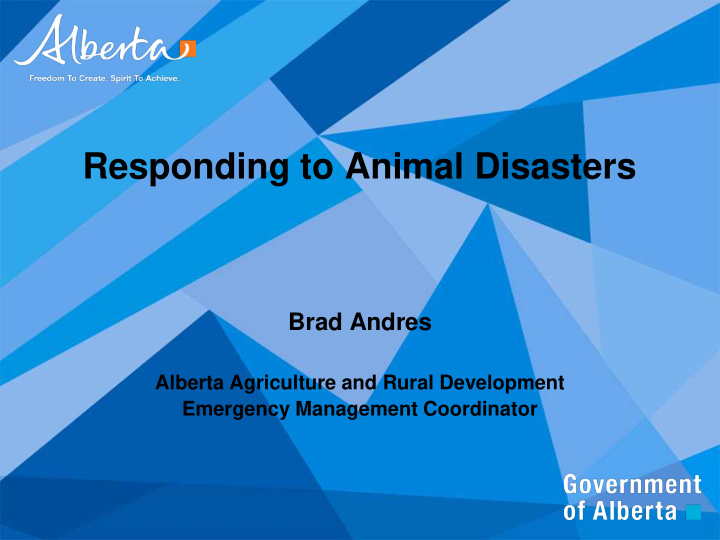



Responding to Animal Disasters Brad Andres Alberta Agriculture and Rural Development Emergency Management Coordinator
Outline • Responding to Animal Disasters • Lessons from recent events • It starts at the Farm • Things we are working on
Responding to Animal Disasters • Disease Outbreaks – CFIA or AB Agriculture • Technological Disasters – Environment, Energy Resources Conservation Board, company • Natural Disasters – Municipality, Provincial Government • Farm Emergencies – Friends and Neighbours, Association, 911
Responding to Animal Disasters • Key players – Producer/Farmer/Rancher/Animal Owner – Veterinarian – Association(s) – AB Equine Federation »Others?
Animal Disease Response - Components • Notification • Containment • Surveillance • Vaccination • Depopulation • Disposal • Cleaning and Disinfection • Communications
Lessons from recent events • H1N1 Influenza in Swine (2009) – Any emerging disease is going to be difficult • Suspect Foot and Mouth Disease processing plant (2010) – Information passage difficult to all potential stakeholders • Salmonella in Eggs ( 2011) – Successful integration of Industry into the response • Equine Influenza (Australia, 2007) – Need to move quickly, with owners and industry engaged
Lessons from recent events – Examples of Movement Control • Australian equine Influenza – Aug 24, 2007 • Full movement control – Immediate state wide stop movement (New South Wales)
Lessons from recent events – disease spread
Australia Equine Influenza Outbreak • 2 weeks after initial outbreak, areas of New South Wales were zoned according to the risk of infection: – 'purple' – Special Restricted areas – „red' zones were infected areas – 'amber' zones were buffer areas around infected areas – 'green' zones were areas that were not infected • Movements then allowed based upon the zone designation • Australian Veterinary Journal Volume 89, Suppl. 1, July 2011 – G Wilson, K Cooper, J Williams, S Eastwood and C Peake – H Scott-Orr
Keys to Success – Australian EI Outbreak http://www.dpi.nsw.gov.au/agriculture/livestock/horses/health/general/influenza/summary-of-the-200708-ei- outbreak • Success in the control of EI due to rapid response, a well rehearsed plan, cooperation from industry and all sectors. • Key factors include the following – Locking down all horse movements. – Quarantining infected properties. – From September, zoning on the basis of risk. – Establishment of buffer zones. • New rapid laboratory tests enabled detection of infected animals using blood tests. Also possible to distinguish infected from vaccinated horses.
Map of farms registered in Premise ID with horses
Lessons from recent events • Associations role in notification, passage of information. • Movement controls on animals and animal products occur quickly. • Engagement at two levels – Policy and strategy of the response and recovery – Day to day operational activities
Natural Disasters
Natural Disasters
Current Projects • Animal Disaster Response Plan • AFAHWSF – Improve Emergency Plans – Portable Livestock Handling Trailers project • Industry integration and improvements in how we respond.
It Starts at the Farm – improve on farm emergency planning • Through the Farmed Animal Health and Welfare Strategy – Prevention and preparations – Everyone does their part – Spread the word • Register in PID • Have animal ID • Health records
Portable Livestock Handling Trailers
Conclusion • Get involved, work with neighbours, groups, and other like minds to improve everyone's level of readiness. • Life will continue to throw us curveballs. – Be prepared • Keep diseases off the farm/ranch/acreage • Be ready for on-farm emergencies • Think about the risks around you • Reality is “You are on your own for 72 hours”
Questions? Brad Andres Emergency Management Coordinator (780) 638 – 3204 brad.andres@gov.ab.ca
Recommend
More recommend